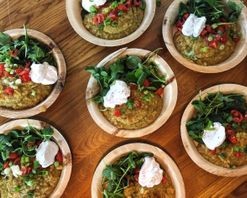
The ancient science of Ayurveda is dominating daily health routines of 21st century wellness warriors.
If you’ve swapped coffee for golden turmeric milk, mouthwash for coconut oil pulling and start your day with a glass of warm lemon water, then you are tapping into ancient art of Ayurveda.
Dry body brushing (to improve circulation and stimulate detoxification), tongue scraping at dawn (to remove build up on the surface of your tongue), daily self massage (to nourish your tissues and calm your mind) and, of course, yoga are other Ayurvedic practices showing up in the morning routines of 21st century wellness warriors.
While it’s been around for some 5000 years, the holistic Indian health science of Ayurveda (Sanskrit for the science of life) is stronger than ever.
This could be partly Ayurveda taps into two of any modern day health enthusiast’s favourite D words: digestion and detoxification.
In Ayurveda, your “agni” or digestive fire is a sign of your overall wellbeing. And while raw juices, salads and acai smoothie bowls are also trending on social media, Ayurvedic converts believe cooked foods such as kitchari (mung bean and rice stew) are easier to digest. To make your own kitchari – there’s a recipe here.
Dosha is another D word you need to know if you want to delve into Ayurveda. There are three doshas: kapha (earth) vata (wind) and pitta (fire) that influence your emotional and physical constitution.
And while everyone has all three elements, one usually dominates. So the trick is to balance them with specific foods, herbs and practices. You can figure out your dosha type here practitioner.
Dylan Smith of Vital Veda says there are ten indicators of good health in Ayurveda – and if you are not experiencing all of them then it’s time to get proactive.
“Ayurveda is about prevention, so when you start to notice symptoms, act before the disease progresses,” he says.
The ten indicators of good health in Ayurveda:
- Proper digestion of food - After you should feel light and energised.
- Good appetite - Hungry at proper meal times.
- Falling asleep easily when going to bed at night.
- "Jumping” out of bed feeling awake each morning.
- Normal functioning of the five sense organs. Our senses should not or only minimally deteriorate over a lifespan.
- Elimination of wastes - Daily bowel motions before any food or drinks. Also regular and comfortable elimination of sweat, urine and menses for women.
- Healthy ratio of muscle, bone and fat tissues – not overweight nor emaciated.
- Natural strength, immunity should be maintained.
- Natural colour of skin should be maintained.
- Peace and contentment of mind
How to DIY Ayurveda at home
If you can’t get to India, there are authentic Ayurveda clinics in Australia (including Vital Veda) where you can experience panchakarma treatments by either taking a few days off work or scheduling treatments at either end of your work day.
- Self-Abhyanga
Self-massage with oil is powerful to increase blood circulation, lymphatic draining, tone the body, calm the nervous system and much more. Most people moisturise daily. I propose you replace that moisturiser with oil - plain sesame or coconut is fine but medicated (oil cooked and infused with whole herbs) is always better (available at Vital Veda), and give yourself a full body massage (see VV website for instructions how to do this), then have shower. After the shower you can apply your moisturiser of choice, but you will need less as your skin will still be lubricated. There is also a quick version for when you are tight for time. Morning or evening is fine. - Sip hot water
This is a powerful technique to melt toxins and flush them out the body. Like washing the dirty grease of dishes with hot water, the same thing happens in your intestines. Sipping plain hot water regularly (frequency, not quantity matters) dilates the channels in your body so things can move better. Don't underestimate this powerful tool. - Eat a light and early dinner
Our digestive fire (agni) is regulated by the sun. Have a light-medium breakfast, good lunch which is the main meal of the day, and a light dinner. Dinner should be lightest because you want to go to sleep without having to digest food. Your body has other things to attend to at night, such as detoxifying the liver, removing stress, rest and healing the body, and if it is overloaded with a job to digest a heavy dinner, the other jobs are jeopardised. - Eat three meals a day and no snacks
This gives our body a chance to switch to the calmer, more stable, detoxifying fuel of its own body fat. Make lunch your main and largest meal of the day. During lunch, take time to sit down, relax and enjoy your meal, with no distractions (newspapers, books, listening to the news, watching screens or electronic devices) – perhaps just some good company and calm conversation. This will help you leave the table satisfied. From there, you can aim for a lighter, smaller and earlier supper. Eating this way requires some blood sugar stability. If three meals a day with no snacks is not possible for you yet, snack on fruit or nuts, and work your way down to three at a comfortable pace. Don’t strain too much, as stress and strain cause the body to store fat rather than burn it.
If you want to know more, Smith has posted a five-day DIY Vital Short Home Cleanse on Vital Veda
To make your own kitchari – there’s a recipe here.
And if you still want to run away to India, go to Dr Raju for more information.



































